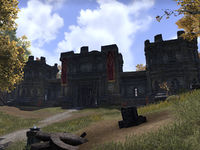Online:Milegates
Milegates are unmanned Imperial checkpoints in Cyrodiil, situated on the borders between the territories controlled by the three Alliances. Each border has three milegates which can be destroyed by Siege Weapons; on the Upper Niben, which marks the border between Aldmeri Territory and Ebonheart Territory, these milegates are also bridges across the river. Destroyed milegates and bridges are impassable for members of all alliances, and can be repaired with Bridge and Milegate Repair Kits from Siege Merchants.
Each border also has one crossing which cannot be destroyed – Dibella's Pass, between Daggerfall and Aldmeri Territory; Silver Tooth Pass, between Ebonheart and Daggerfall Territory; and the goat path at Lunar Fang Docks between Aldmeri and Ebonheart Territory.
Milegates[edit]
Three segments of milegates are destructible; the central portcullis, and the left and right parapets. Destroying the central portcullis will block access from one direction, but the parapets can still be accessed by wooden scaffolding steps from one side. A milegate which is blocked in this manner will be shown with a ! on the map and compass. To completely destroy the milegate and cut off access from both sides, the parapets and scaffolding must be destroyed as well. A completely destroyed milegate is marked with a X on the map and compass.
 Ash Milegate — An Imperial milegate in western Cyrodiil, southeast of Fort Ash, on the border between Covenant and Dominion territories. (map)
Ash Milegate — An Imperial milegate in western Cyrodiil, southeast of Fort Ash, on the border between Covenant and Dominion territories. (map) Chalman Milegate — An Imperial milegate in northern Cyrodiil, southwest of Chalman Keep, on the border between Pact and Covenant territories. (map)
Chalman Milegate — An Imperial milegate in northern Cyrodiil, southwest of Chalman Keep, on the border between Pact and Covenant territories. (map) Chorrol Milegate — An Imperial milegate in western Cyrodiil, south of Chorrol, on the border between Covenant and Dominion territories. (map)
Chorrol Milegate — An Imperial milegate in western Cyrodiil, south of Chorrol, on the border between Covenant and Dominion territories. (map) Horunn Milegate — An Imperial milegate in northern Cyrodiil, northwest of Wilminn's Winery, on the border between Pact and Covenant territories. (map)
Horunn Milegate — An Imperial milegate in northern Cyrodiil, northwest of Wilminn's Winery, on the border between Pact and Covenant territories. (map) Kingscrest Milegate — An Imperial milegate in northeastern Cyrodiil, northwest of Kingscrest Keep, on the border between Pact and Covenant territories. (map)
Kingscrest Milegate — An Imperial milegate in northeastern Cyrodiil, northwest of Kingscrest Keep, on the border between Pact and Covenant territories. (map) Priory Milegate — An Imperial milegate in western Cyrodiil, southeast of Weynon Priory, on the border between Covenant and Dominion territories. (map)
Priory Milegate — An Imperial milegate in western Cyrodiil, southeast of Weynon Priory, on the border between Covenant and Dominion territories. (map)
Bridges[edit]
Three segments of bridges are destructible; the main span of the bridge itself, and the two gatehouses. Destroying the main span is all that is needed to block access from both directions; destroying the gatehouses as well reduces the amount of high ground available for retaliating siege weapons. A destroyed bridge is marked with a X on the map and compass. There is no indicator for destroyed bridge gatehouses.
 Alessia Bridge — A bridge in southern Cyrodiil, northeast of Castle Alessia, acting as a milegate between Dominion and Pact territories. (map)
Alessia Bridge — A bridge in southern Cyrodiil, northeast of Castle Alessia, acting as a milegate between Dominion and Pact territories. (map) Bay Bridge — A bridge in southeastern Cyrodiil, northeast of Castle Bloodmayne, acting as a milegate between Dominion and Pact territories. (map)
Bay Bridge — A bridge in southeastern Cyrodiil, northeast of Castle Bloodmayne, acting as a milegate between Dominion and Pact territories. (map) Niben River Bridge — A bridge in southeastern Cyrodiil, west of Culotte, acting as a milegate between Dominion and Pact territories. (map)
Niben River Bridge — A bridge in southeastern Cyrodiil, west of Culotte, acting as a milegate between Dominion and Pact territories. (map)
Notes[edit]
- The destructible bridges and milegates feature was added with Update 20. Prior to this, these fixtures were unmarked on the map, and had a different structural design.
|
|||||||||||||||||||
